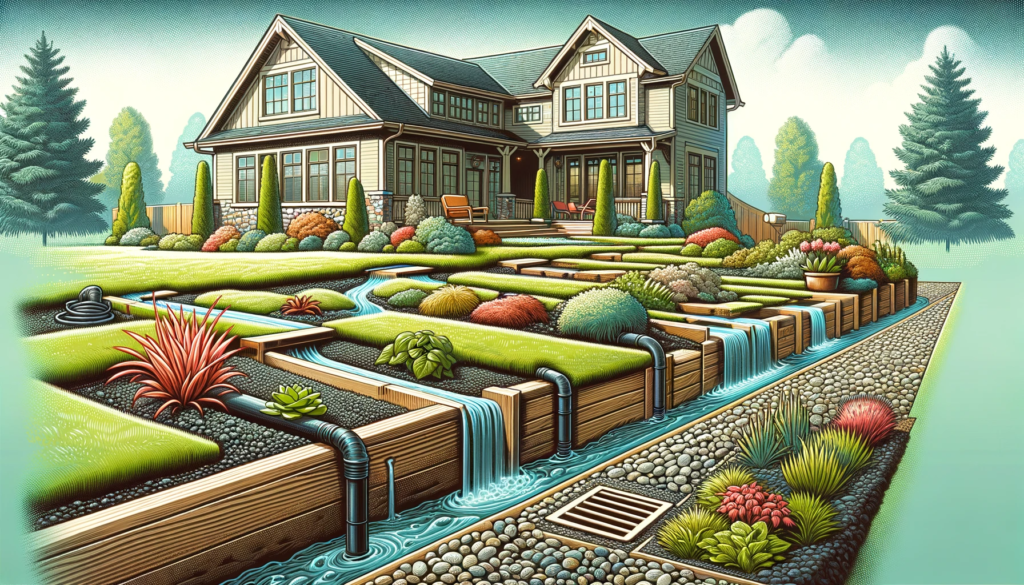Tackling Common Yard Drainage Issues: A Homeowner’s Guide

Understanding Yard Drainage Basics
As a homeowner, I’ve learned the hard way that proper drainage is vital for protecting my property and maintaining my yard’s appearance. Drainage issues can lead to a host of problems, from waterlogged plants to serious foundation damage. That’s why grasping the basics of yard drainage is essential.
Table: Key Components of Yard Drainage
| Component | Function |
|---|---|
| Gutters & Downspouts | Redirect roof runoff away from the foundation |
| Grading | Ensures slope directs water away from home |
| Drains | Collect and redirect surface water |
| Permeable Surfaces | Allows water to seep through to the soil |
It’s important to understand that yard drainage is not just about dealing with excess water, but rather managing water flow around your property to prevent damage and erosion. If you’re entirely new to this, a good starting point is checking out Understanding Residential Drains, which provides a comprehensive look into the nature of residential drainage systems.
Identifying Signs of Poor Drainage
Recognizing the warning signs of drainage issues is crucial in warding off potential damage. In my own yard, the first red flag waved at me in the form of standing water. After a good rainstorm, certain areas would take an age to dry out. It wasn’t just unsightly; it indicated deeper problems.
List: Signs of Poor Drainage
- Puddles that linger long after rain
- Soil erosion in specific areas
- Over-saturated garden beds or lawns
- Water stains on foundation walls
- Mildew or mold in basements or crawlspaces
These symptoms suggest that your yard isn’t handling rainwater effectively. This can lead to compromised plant health, attract pests like mosquitoes, and even risk water intrusion into your home. Now, if these signs ring alarm bells for you, then I recommend delving into further details on the Common Drain Problems page. Knowledge here can save you a bundle in repair costs down the line.
Exploring Drainage Solutions
After identifying the warning signs, the next step is to explore drainage solutions. There are various ways to address yard drainage issues, and the right approach often depends on the specific problems and the layout of your yard. I learned that solutions could range from simple fixes like adjusting gutter downspouts to more complex systems such as installing a French drain.
Table: Common Yard Drainage Solutions
| Solution Type | Description |
|---|---|
| French Drains | A gravel-filled trench that redirects water |
| Dry Wells | Underground basins that collect excess water |
| Rain Gardens | Landscaped areas that absorb rainwater |
| Channel Drains | Drains that intercept and reroute surface water |
Each solution has its place, and sometimes, a combination of methods is required. To get a better grasp of the various systems that could remedy your yard’s water woes, it’s worth reading up on Types of Home Drainage Systems. This resource helped me understand what might work best for my situation.
DIY vs. Professional Drain Installation
Deciding between a DIY project and hiring a professional for drain installation was a significant decision for me. On one hand, DIY can be cost-effective and allows for a personalized touch. On the other, professionals bring expertise and often, a guarantee for their work.
List: Pros & Cons of DIY Drain Installation
- Pros:
- Reduced costs if you have the necessary skills
- Flexibility to work on your own timeline
- Personal satisfaction from completing the work yourself
- Cons:
- Risk of improper installation leading to further issues
- Time-consuming, especially without prior experience
- Potential for increased costs if mistakes occur
For anyone considering the DIY route, there’s a guide that I found particularly helpful called DIY Drain Installation, which walks you through the basic steps. It’s a great resource if you’re looking to understand what the task entails and evaluate whether you’re up for the challenge.
Maintaining Your Drainage System
Once you’ve installed the right drainage solution, maintenance is key to ensuring it performs effectively over time. Routine maintenance prevents minor issues from becoming major, costly repairs. I learned that simple actions can have a significant impact on the longevity of my drainage system.
Table: Drainage System Maintenance Tips
| Maintenance Tip | Benefit |
|---|---|
| Regularly clean gutters and downspouts | Prevents blockages and water overflow |
| Inspect and clear out drain outlets | Ensures water can flow freely |
| Check for and repair any erosion or damage | Stops small issues from becoming big problems |
| Flush drains with water to remove debris | Keeps underground pipes clear |
Consistency is what keeps your system at peak efficiency. For a deeper dive into upkeep, Drain Maintenance Tips outlines the essential practices that can save you from headaches after heavy rains.
Eco-Friendly and Cost-Effective Drainage Strategies
Eco-friendly solutions are not just beneficial for the environment; they can also be cost-effective in the long run. I opted for a rain garden in my yard, which serves as a natural basin for rainwater, allowing it to soak into the ground while providing a habitat for local wildlife. Utilizing native plants reduces the need for water and fertilizers, cutting down on maintenance costs.
List: Strategies for Eco-Friendly Drainage
- Use rain barrels to collect runoff for garden watering
- Plant a rain garden with native, water-tolerant plants
- Install permeable pavers for patios and walkways
- Consider a green roof to absorb rainfall
Balancing eco-friendliness with affordability is easier than you might think. Resources such as Eco-Friendly Drain Solutions and Cost-Effective Drainage are invaluable in guiding homeowners toward sustainable and economically smart choices.
Preventing Future Drainage Issues
Prevention is better than cure, especially when it comes to drainage. I make it a habit to walk around my property after storms to check for any new signs of drainage problems. Investments made in landscaping, such as proper grading or adding plants that absorb excess water, pay off by preventing erosion and water accumulation.
List: Preventative Measures for Drainage
- Regularly evaluate yard slope and make adjustments as needed
- Add organic matter to soil to improve absorption capacity
- Divert downspouts away from the foundation
- Maintain a regular cleaning schedule for gutters and drains
Intervening early when small issues arise is fundamental. For those looking to be proactive about their yard’s health, further reading on Preventing Drain Blockages provides a treasure trove of actionable tips.
Conclusion
In conclusion, solving yard drainage issues doesn’t have to be a daunting task. With a solid understanding of the problem, the right solutions at hand, and a commitment to maintenance, you can effectively manage water in your landscape. Whether you do it yourself or hire a professional, the ultimate goal is to create a yard that’s both beautiful and functional.
Remember, taking steps to prevent drainage problems not only protects your property but also enhances its value and the health of your local ecosystem. It’s a win for you, your home, and the environment.
For further reading on this topic and related matters, visit Drain Fix Pros. Happy troubleshooting, and may your gardens stay gloriously dry!




